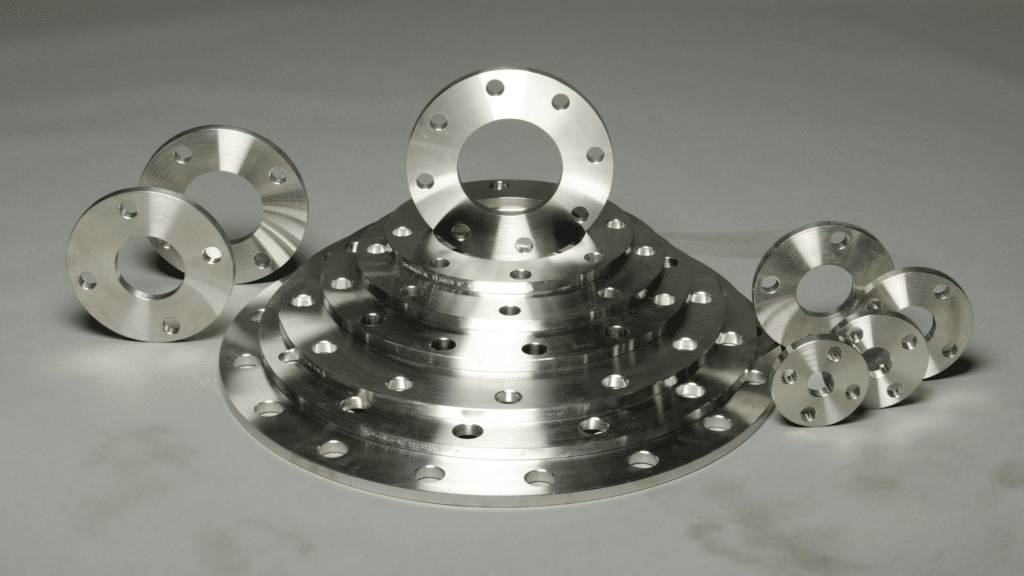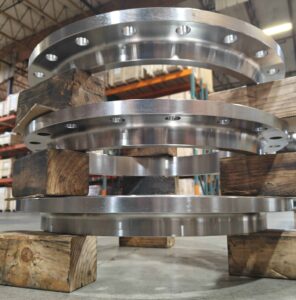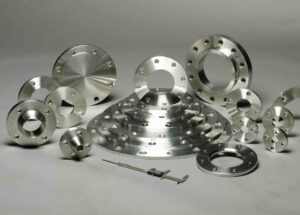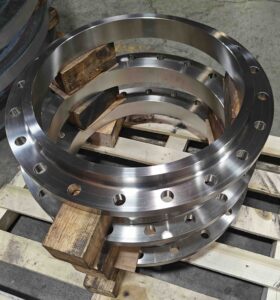When high durability and corrosion resistance are required, stainless steel flanges and fittings are often suitable choices. Stainless steel offers improved longevity over hot dip galvanized steel as it’s stronger and more corrosion-resistant. When selecting the appropriate stainless steel flanges and fittings, consider the specific manufacturing technique used to produce the stainless steel—the most common options are forged, cast, or cut. You’ll also choose the grade that suits your intended application.
Benefits of Stainless Steel Flanges and Fittings
Stainless steel is corrosion-resistant due to the addition of chromium, the source of the thin oxide layer at the material’s surface. This passive layer protects the material, but corrosion and rust still may occur if the protective layer is damaged. Stainless steel is incredibly durable and easy to maintain—and it’s self-healing. The protective chromium barrier at the material’s surface can re-form to repair limited surface damage.
Appropriate flange and fitting maintenance aids in the continued prevention of rust and surface damage. Corrosion may still occur with exposure to salt, such as in coastal atmospheres or when vulnerable to road salt. To keep stainless steel components performing their best, choose the correct grade for your intended application and remove corrosive substances and rust by using appropriate solvents as part of regular maintenance.
It’s a versatile option for piping systems, as well. Stainless steel components can be modified or fabricated to your exact specifications to create custom flange or fitting solutions.
What Applications Are Stainless Steel Flanges Used For?
Stainless steel flanges and fittings are used in residential, commercial, and industrial piping systems. The strength, corrosion resistance, and ability to withstand high temperature, pressure, and flow make stainless steel a common choice for the transport of gasses or liquids, for chemical processing, in maritime applications, for sanitary use, and where corrosion resistance is required. Refer to the appropriate standards or contact us if you need assistance choosing the correct stainless steel grade and flange type for your intended application.
Common Stainless Steel Flange Types
Stainless steel flanges are available to meet a variety of standards, including AWWA, DIN or metric, and ANSI-class rated. Within these standards, you can find the most common flange types—and custom machining is available to tailor flanges to your individual needs and intended application.
The most common stainless steel flange types include:
- Weld-Neck
- Slip-On or Ring
- Socket Weld
- Lap Joint
- Blind
In addition to flanges, threaded couplings, nipples, braided pump connectors, elbows, and other piping system components are available in stainless steel. Refer to the standards for your intended application to determine the appropriate stainless steel piping system components.
Which Standards Apply to Stainless Steel Flanges and Fittings?
A variety of standards establish the required chemical composition, dimensions, pressure ratings, and other requirements of flange and fitting materials for piping systems. The standards most often applied to stainless steel include:
- AWWA C228 sets the minimum material requirements and dimensions for stainless steel flanges used in stainless steel piping systems
- ASTM A182 covers forged or rolled piping system components intended for high-temperature service
- ASME B16.5 is a dimensional standard applied to pipe flanges and flange fittings, including stainless steel
- ASME B16.34 is a pressure/temperature rating applied to threaded and welded valves used to connect flanges
- ASME B16.47 is specific to large-diameter steel and stainless steel flanges
Choosing Stainless Steel Grade for Flanges
When choosing stainless steel flanges, fittings, and accessories, you’ll need the appropriate grade to suit your intended application. The most common options are 304 and 316 stainless steel, which are preferred for strength even under heavy stress. However, the correct grade of stainless steel is necessary to ensure it can withstand the intended use. Using an incorrect grade at high temperatures may result in warping or otherwise compromise the piping system. Choosing the appropriate grade to suit the intended application helps prevent piping system damage or early failure.
What’s the Difference Between 304 and 316 Stainless Steel?
While both 304 and 316 stainless steel are corrosion-resistant, 316 stainless steel includes nickel and molybdenum for better performance at higher temperatures and improved corrosion resistance. Because it offers better resistance to pitting corrosion from saltwater, 316 stainless steel is preferred for marine environments over 304 stainless steel.
What Does the L Mean in Stainless Steel?
Stainless steel is available 304 and 304L and 316 and 316L. The L designates stainless steel with a lower carbon content than the standard 304 or 316, so it is softer and offers improved weldability. Each of these options—304, 304L, 316, and 316L—offers corrosion resistance and high tensile strength, but 304L and 316L are more corrosion-resistant than 304 or 316. Stainless steel with high carbon content is designated with an H, as in 304H or 316H, and is preferred for improved tensile strength at higher temperatures.
Dual grade 304/304L or 316/316L stainless steel material meets more than one standard. For example, 304/304L stainless steel’s chemical composition meets the certification requirements for 304L stainless steel and the requirements for 304 stainless steel. Dual grade stainless steel conforms to AWWA C228 specifications.
Stainless Steel Piping Systems for Saltwater Exposure
When choosing components for your piping system, determine the temperature range and tensile stress expected, how much saltwater exposure the piping system will get, and what other elements to which the components may be exposed. In areas with saline environments—applications with high saltwater exposure such as for maritime use or in splash zones—316, 316L, or dual 316/316L stainless steel may be the best option due to its increased corrosion resistance.
Stainless steel flanges are durable, corrosion-resistant piping system components. Contact us for more information about which stainless steel piping system components meet your specifications.





